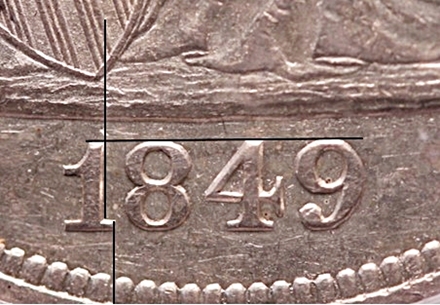Comments:
This is the second and final use of Obverse 1 and the only use of Reverse A.
|
Obverse 1
Obverse 1 is the only business strike obverse die. The photo below shows the attribution grid.


1849 Obverse 1 attribution grid
Obverse 1 Die States
- Perfect die. Die polish lines extend up to the left from the denticles right of the date into the field.
- The die lines from the denticles have been removed by die polishing.
No later die states have been observed. OC-2 is found only with obverse die state b.
|
Reverse A
1849 Reverse A exhibits virtually nothing in the way of die markers to allow easy identification.
The best identification point is the LACK of the two parallel die lines in recess #4, as well as
the LACK of the die lines at the top of recess #1 (see 1849 OC-1 for photos of these die lines).
The die cracked in later states, but the cracks are so tiny that they can be easily missed,
particularly on lower grade coins.

Reverse 1849 A Die States
- Perfect die.
- Faint die cracks - from the field above N across the top of NIT into the field above E1; from the upper right serif of
E1 across the top of D to the rim above S1; joining the top of RIC. The cracks are very faint, visible only under a glass.
- The die cracks are stronger An additional crack has appeared across the bottom of NE D to the rim between OL.
OC-2 is normally seen with 5-10 degrees counterclockwise die rotation. We’ve examined over 100 examples
of this die marriage. All of them have exhibited this die rotation. It’s possible that an unrotated
example exists, but if so we’ve never seen it. This gives us another way to attribute the die marriage.
Any examples exhibiting slightly rotated dies will be OC-2, whereas OC-1 examples have perfect die alignment.
|

